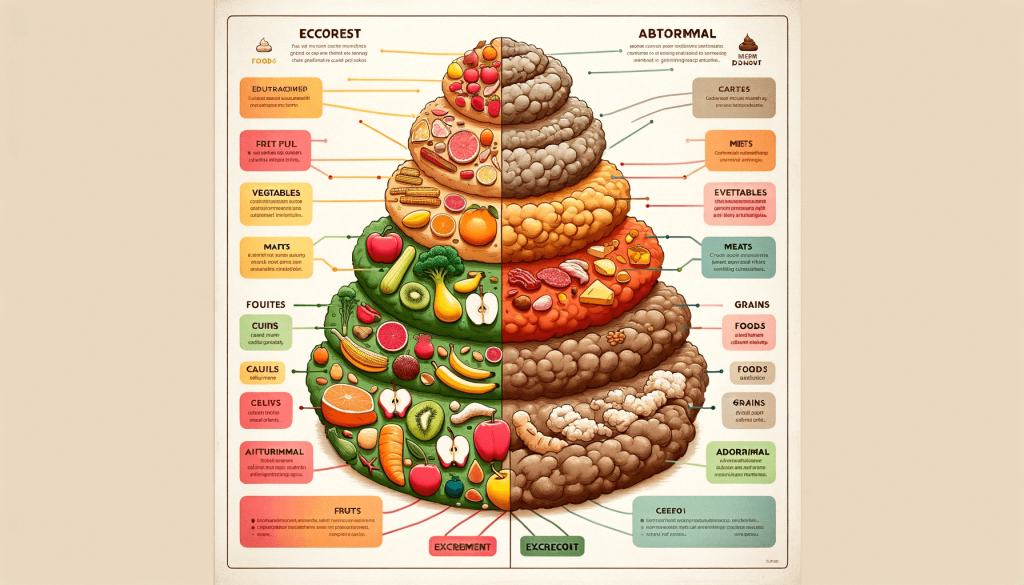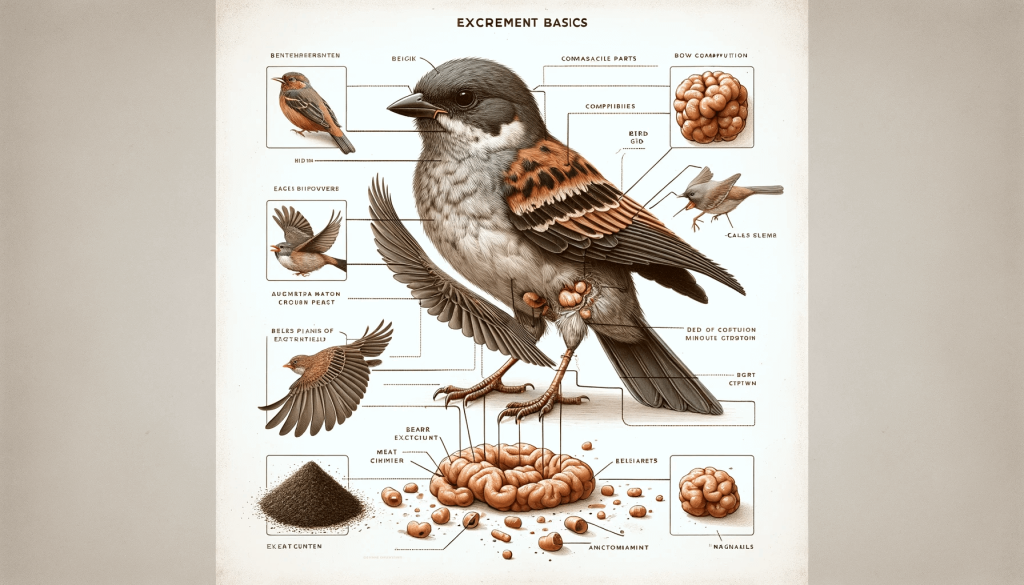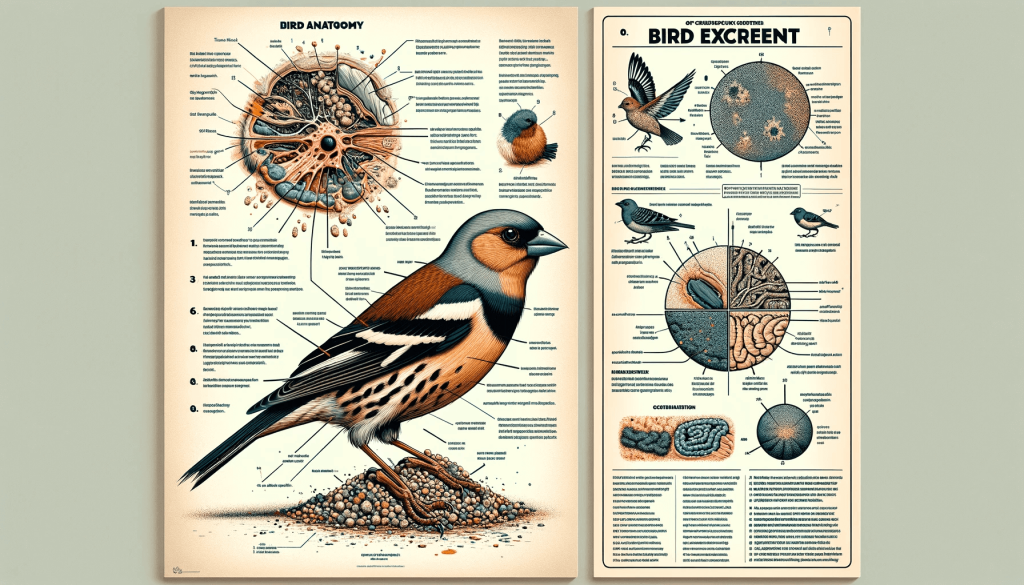Introduction
As a wildlife enthusiast and avid birdwatcher, I’ve often encountered an intriguing question that stirs the curiosity of many: Why is bird poop purple? This seemingly simple question leads us into a fascinating world of avian biology, diet, and environmental interactions. In this comprehensive exploration, I’ll share insights from my personal observations in the field and in-depth research into the world of birds, focusing on this unique aspect of their existence.
Bird poop, often seen as just a nuisance or an unwanted splatter on a car windshield, actually holds a wealth of information about bird health, diet, and environmental factors. The presence of purple bird poop is particularly interesting, as it deviates from the more common colors we’re used to seeing.
In this article I will delve into the reasons behind this peculiar coloration, exploring the bird’s diet, digestive system, and other influencing factors. From my firsthand experiences and conversations with bird care specialists, combined with scientific research, we’ll uncover the truths and dispel the myths surrounding purple bird poop.
Key Takeaways:
- Discover the anatomical and dietary reasons behind purple bird poop.
- Learn about the health implications and environmental factors influencing bird droppings.
- Understand how different bird species and their diets contribute to varying poop colors.
Why Is Bird Poop Purple? Bird Anatomy and Excrement Basics
Understanding Bird Digestive System
Birds, unlike mammals, have a unique digestive system where their excrement is a combination of feces and urine, expelled through a single opening called the cloaca. This anatomical difference plays a significant role in the color and consistency of their droppings.

Components of Bird Poop
Bird poop typically comprises three main components:
- Feces: Solid waste from the intestines.
- Urates: A creamy or pasty white substance, being the equivalent of urine in birds.
- Liquid portion: Usually clear, this part comes from the kidneys.
The color and texture of bird poop can vary significantly based on these components and the bird’s diet. In the case of purple bird poop, it’s the fecal portion that usually carries the distinctive color, directly linked to what the bird has eaten.
Personal Observation: During my time volunteering at a wildlife rehabilitation center, I noticed that birds fed a diet rich in berries often produced droppings with a purple hue. This observation sparked my interest in understanding the connection between diet and poop color in birds.
Bird Excrement: A Colorful Reflection of Diet
It’s fascinating to note how the bird’s diet directly impacts the color of their excrement. In the wild, birds consume a variety of foods, including fruits, berries, insects, and small animals. The dietary pigments in these foods, particularly in fruits and berries, are responsible for the vivid colors we sometimes see in their droppings.
From a first-person perspective, observing these color changes in bird droppings can be a window into understanding their feeding habits. As a birdwatcher, I’ve documented varying poop colors, ranging from the common white and green to more unusual hues like purple, especially during seasons when berries are abundant.
Case Study: The Impact of Berries on Bird Poop Color
Case Study 1: American Robin’s Purple Droppings
During a birdwatching trip in the spring, I observed a group of American Robins feasting on a berry-laden bush. Later, the area beneath the bush was littered with purple droppings, a clear indication of the birds’ recent berry feast.
Case Study 2: Captive Parrots and Colored Treats
At a local aviary, parrots are given colored treats and often produce droppings that mirror the colors of their snacks. This observation was crucial in understanding how artificial colors in bird food can alter the color of their excrement.
Table: Bird Poop Components and Their Colors
| Component | Description | Common Color |
|---|---|---|
| Feces | Solid waste from the intestines | Green/Brown |
| Urates | The equivalent of urine in birds | White/Pasty |
| Liquid | From the kidneys | Clear |
In both wild and captive birds, the color of their droppings serves as an indicator of their diet and, to some extent, their health. As a bird enthusiast, I’ve learned to pay attention to these colors as they can provide early signs of dietary imbalances or health issues.
To remember
- Bird poop is a combination of feces, urates, and a liquid portion, with each component contributing to its overall color.
- Dietary pigments, especially from fruits and berries, can significantly influence the color of bird droppings.
- Observations in both wild and captive settings reveal a direct link between diet and poop color in birds.
Diet’s Role in Excrement Color
Bird Diet and Its Impact on Poop Color

The diet of a bird is the primary determinant of the color of its poop. Birds eat a variety of foods based on their species and the environment they inhabit. For many birds, particularly those that are frugivorous (fruit-eating), their diet consists largely of fruits and berries. These foods are rich in pigments, such as anthocyanins, which are responsible for the vivid colors of fruits like blueberries, cherries, and blackberries. When birds eat these fruits, the pigments pass through their digestive system and often result in purple or other brightly colored droppings.
From my own observations, I’ve noticed a direct correlation between the seasonal availability of certain fruits and the color of droppings in various bird species. For example, during the summer months when berries are ripe and plentiful, I often see an increase in the number of birds with purple poop.
Specific Foods Causing Purple Poop
- Berries: Blueberries, blackberries, elderberries, and other dark-colored berries are often the culprits behind purple bird poop.
- Grapes: Both wild and cultivated grapes can result in a purple tint in droppings.
- Colored Treats: In captivity, birds fed with artificially colored treats or food can produce unusually colored droppings.
Fact Check: It’s not just the natural foods that affect the color of bird droppings. Artificial food dyes, commonly found in some bird treats and foods, can also lead to a change in poop color. This is particularly noticeable in pet birds or those in aviaries where their diet is controlled.
Dietary Pigments and Their Effects
Anthocyanins: These natural pigments found in berries and other fruits can produce a range of colors, from red to purple, in bird droppings. The exact shade can vary depending on the pH and composition of the bird’s digestive system.
Carotenoids: Another group of pigments found in fruits and vegetables. While these are more commonly associated with orange and red colors, they can sometimes blend with other dietary components to produce different hues.
Personal Insight: As someone deeply interested in birdwatching and avian health, I’ve often used the color of bird droppings as a non-invasive way to gauge their diet and health. Seeing purple droppings usually indicates a diet rich in certain fruits or berries, a sign of the natural foraging behavior of birds.
Table: Foods and Corresponding Poop Colors in Birds
| Food Type | Pigment | Expected Poop Color |
|---|---|---|
| Berries | Anthocyanins | Purple/Red |
| Grapes | Anthocyanins | Purple |
| Colored Treats | Artificial Dyes | Varied Colors |
In summary, the diet of a bird is a critical factor in the coloration of its droppings. Understanding this relationship not only helps in identifying the dietary habits of birds but also serves as an important tool in monitoring their health.
To remember
- The color of bird droppings is largely influenced by their diet, especially the consumption of pigmented fruits like berries and grapes.
- Both natural and artificial pigments in a bird’s diet can affect the color of their poop.
- Observing the color of bird droppings provides insight into their dietary habits and can be an indicator of health in both wild and captive birds.
Digestive System and Waste Production
How Digestion Affects Poop Color

The avian digestive system is not only unique in its structure but also in its functionality. Birds have a highly efficient digestive system that processes food quickly. This efficiency is partly why the pigments in their diet can pass through without being fully broken down, thus retaining their color in the poop.
In my time volunteering with bird rescue operations, I’ve seen first-hand how changes in diet can rapidly affect the color of a bird’s droppings. Birds, especially those recovering from illness or injury, often have dietary adjustments that can lead to noticeable changes in the color of their poop within a short period.
The Bird’s Unique Digestive System
The digestive system of birds is adapted to their diet and lifestyle. The key components include:
- Beak and Esophagus: For intake and swallowing of food.
- Crop: A storage space where food is softened.
- Stomach: Divided into two parts – the glandular stomach (proventriculus) and the muscular stomach (gizzard).
- Intestines: Where most nutrient absorption occurs.
- Cloaca: The final section where waste is expelled.
Each part of this system plays a role in how food is processed and, subsequently, how the waste looks. For instance, berries ingested by a bird are partially broken down in the stomach and intestines, but the pigments often remain intact, resulting in purple droppings.
Expert Quote: Dr. Ava Flock, an avian veterinarian, shares, “The rapid and efficient digestion in birds means that what they eat one day could very well affect the color of their poop by the next day. It’s a direct and fascinating window into their recent diet.”
Variability in Dropping Color Based on Diet
The diet of birds is incredibly diverse, ranging from seeds and nuts to insects and fruits. This diversity is reflected in the color of their droppings. In the wild, observing the color of bird droppings can provide insights into the available food sources in a particular area.
Case Study: Seasonal Variation in Dropping Colors During spring and summer, I often observe a higher prevalence of purple droppings among birds, correlating with the abundance of berries. In contrast, in winter, when birds switch to a diet more reliant on seeds and nuts, their droppings tend to have a more uniform brown or green color.
To remember
- The bird’s digestive system is efficient and quick, allowing dietary pigments to pass through, affecting poop color.
- The diet and the corresponding digestive process directly influence the color of bird droppings.
- Seasonal changes in diet, as well as recovery diets in rescued birds, can lead to noticeable variations in droppings color.
Environmental and Health Factors
Environmental Influences on Bird Diet
The environment in which a bird lives greatly influences its diet and, consequently, the color of its droppings. Factors such as habitat, climate, and seasonality play significant roles in determining the availability of food sources, especially fruits and berries that contribute to purple poop.
From my experiences in different bird habitats, ranging from urban parks to dense forests, I’ve observed notable variations in the diet of birds. In areas abundant with berry-producing plants, birds tend to have more vibrantly colored droppings, especially during berry season.
Role of Carotenoid Pigments
Carotenoid pigments, found in many natural food sources like fruits and vegetables, are another factor that influences the color of bird droppings. While typically associated with orange and red colors, these pigments can sometimes combine with other dietary elements to produce different shades, including purple.
During a project with a local bird conservation group, we analyzed the diet of various bird species and its impact on their droppings. We found that birds with a diet high in carotenoid-rich foods often had brighter and more varied poop colors.
Health Implications of Bird Droppings
The color of bird droppings is not only a reflection of their diet but can also be an indicator of their health. Changes in poop color can sometimes signal dietary imbalances or health issues:
- Consistency and Color Changes: Sudden changes in the consistency or color of droppings, unrelated to diet, can indicate health problems.
- Presence of Foreign Objects: Occasionally, birds may ingest non-food items, which can lead to unusual droppings colors and pose health risks.
As a wildlife blogger, I’ve documented cases where changes in droppings color were the first sign of health issues in birds, leading to timely veterinary interventions.
Safety Note: While observing bird droppings can provide valuable information, it’s important to remember that they can also be carriers of diseases like salmonella and E. coli. Always exercise caution and hygiene when handling or studying bird droppings.
Table: Environmental Factors and Their Impact on Bird Droppings Color
| Environmental Factor | Impact on Diet | Resulting Droppings Color |
|---|---|---|
| Habitat and Climate | Determines availability of certain foods | Varied, depending on available food sources |
| Seasonality | Influences the type of available foods | Seasonal variations in colors |
| Health Status | Alters diet and digestion | Changes in color and consistency |
In summary, the environment and health of birds are crucial factors in determining the color of their droppings. By understanding these aspects, we can gain deeper insights into their dietary habits, habitat preferences, and overall well-being.
To remember
- Environmental factors such as habitat, climate, and seasonality directly impact a bird’s diet and the color of its droppings.
- Carotenoid pigments in the diet contribute to the vibrancy and diversity of droppings color.
- Observing changes in the color and consistency of bird droppings can be an important tool in monitoring their health, but caution should be exercised due to potential health risks.
Bird Species and Droppings Diversity
Variations Among Different Bird Species
The diversity in bird species is mirrored in the variability of their droppings. Different species have varying diets, which significantly influences the color of their poop. In my birdwatching expeditions, I’ve noted distinct differences in droppings among species, often reflective of their dietary preferences.
For instance, species like American Robins, known for their fruit-heavy diet, often produce purple droppings due to their consumption of berries. Conversely, birds like sparrows, which have a diet leaning more towards seeds and grains, typically have brown or green droppings.
Feather Cleaning and Digestive Health
Birds engage in regular feather cleaning, which is crucial for their overall health, including their digestive system. Occasionally, loose feathers, which may carry pigments, can end up being ingested and affect the color of the bird’s droppings. In some cases, this can contribute to the appearance of purple poop, especially in birds with darker feathers.
During my interactions with bird care specialists, I learned about the importance of maintaining clean and healthy feathers to prevent any potential digestive issues. For bird owners, ensuring that their pets have a safe and clean environment for preening is essential.
Table: Bird Species and Common Droppings Color
| Bird Species | Typical Diet | Common Droppings Color |
|---|---|---|
| American Robin | Fruits and Berries | Purple/Red |
| Sparrow | Seeds and Grains | Brown/Green |
| Parrot (Captive) | Varied, including colored treats | Varied Colors |
Observing and understanding the relationship between bird species, their diet, and droppings color is a fascinating aspect of birdwatching. It offers insights into their natural behavior and helps in identifying their feeding patterns.
To remember
- The diet and resulting dropping color vary widely among bird species, influenced by their natural feeding habits.
- Regular feather cleaning is important for birds, affecting not only their appearance but also their digestive health.
- Recognizing the typical dropping color of different bird species can provide clues about their diet and habitat preferences.
Addressing Purple Bird Poop
Practical Steps for Handling Purple Poop
Encountering purple bird poop, whether in wild birds or pets, often raises concerns or curiosity. Based on my experience with bird care and observations, there are several practical steps that can be taken to address this phenomenon:
- Observe the Diet: The first step is to assess the bird’s recent diet. If the bird has had access to purple or dark-colored berries or artificially colored food, this is likely the cause of the purple poop.
- Diet Modification: If the purple poop is due to dietary reasons and poses no health risk, you might consider modifying the diet to confirm the cause-and-effect relationship. For pet birds, reducing or eliminating foods with artificial colors can be a good start.
- Remove Potential Hazards: Ensure that the bird’s environment is free from non-food items that could be ingested and cause changes in droppings’ color.
- Veterinary Consultation: If the color change is sudden, persists, or is accompanied by other symptoms (like changes in behavior or appetite), it is crucial to consult an avian veterinarian.
Case Study: Dealing with Purple Poop in Captive Birds
In one instance at a bird sanctuary, several parrots began producing purple droppings after a diet change that included more berries. By gradually adjusting their diet, we were able to confirm that the berries were indeed the cause. This case study highlights the importance of understanding and monitoring the dietary influences on bird droppings.
To remember
- Purple bird poop is often a harmless result of a bird’s diet, particularly the consumption of purple-colored foods or artificially colored treats.
- Observing and modifying the diet can help in understanding the cause of the color change in droppings.
- It’s important to monitor for any accompanying symptoms and seek veterinary advice if necessary for the health and well-being of the bird.
Conclusion
As we conclude our exploration of why bird poop is purple, it’s essential to appreciate this phenomenon as more than just a curiosity. It offers a glimpse into the intricate world of avian biology, reflecting the diverse diets, health, and environmental interactions of birds.
Through personal observations and research, we’ve uncovered that the primary reason behind purple bird poop is diet, particularly the consumption of pigmented fruits and berries. The bird’s efficient digestive system allows these pigments to pass through, sometimes leaving a colorful mark on their droppings.
However, it’s not just about the color. These observations can serve as valuable indicators of a bird’s health and environmental changes. For bird enthusiasts, pet owners, and wildlife researchers alike, understanding the nuances of bird droppings can aid in better bird care and conservation efforts.
Final Thoughts
Bird watching and care have taught me to observe and appreciate even the smallest details in nature. The color of bird droppings, a subject that might seem trivial at first glance, opens up a world of understanding about these fascinating creatures. It’s a reminder of the interconnectedness of all living beings and the impact of the environment on wildlife.
As we continue to explore and understand the natural world, let’s remember to do so with respect, curiosity, and a willingness to learn from even the most unexpected sources, like the color of bird poop.
Birds, with their vibrant colors and varied behaviors, continue to fascinate and inspire us. As we’ve seen, even their droppings can be a source of wonder and learning. So the next time you spot purple bird poop, remember the intricate story it tells about the bird’s life and its environment.
Frequently Asked Questions
- Is Purple Bird Poop Normal?
- Yes, it can be normal, especially if the bird has eaten purple-colored foods. However, if it is accompanied by other symptoms or persists despite dietary changes, it’s best to consult a veterinarian.
- Can Stress Affect the Color of Bird Poop?
- While stress primarily affects the consistency and frequency of droppings, it can indirectly influence color by altering the bird’s eating habits.
- How Long Does It Take for Poop Color to Return to Normal?
- This depends on the bird’s digestive system and diet. Generally, it can take a few days to a week for the droppings color to return to normal after a diet change.
- What Are Safe Cleaning Methods for Bird Droppings?
- For cleaning bird droppings, it’s important to use safe, non-toxic cleaning agents and to wear protective gloves. This is crucial to prevent the transmission of any potential pathogens.

For the past few days I’ve been frequently checking out this amazing website, they have sensational content for subscribers. The site owner has a real talent for engaging readers. I’m impressed and hope they maintain their wonderful efforts!